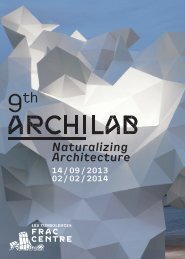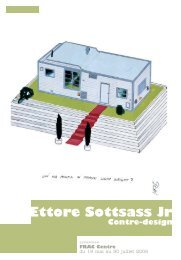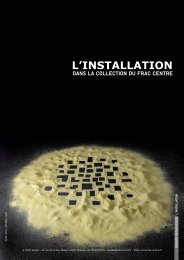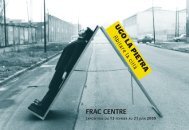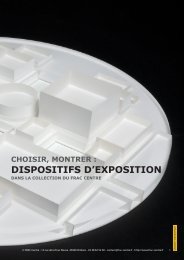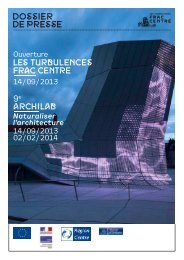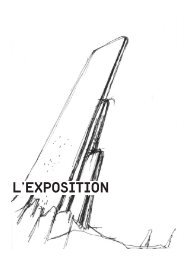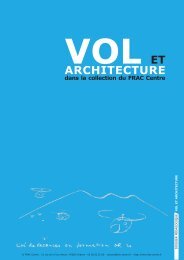Monoliths - FRAC Centre
Monoliths - FRAC Centre
Monoliths - FRAC Centre
Create successful ePaper yourself
Turn your PDF publications into a flip-book with our unique Google optimized e-Paper software.
PRESS RELEASEle 21 juillet 2010<strong>Monoliths</strong>or architecture insuspense (1950-2010)Artists and architects in the<strong>FRAC</strong> <strong>Centre</strong> collectionExhibition from September 18, 2010 to January 30, 2011Vernissage : Tuesday October 5th, 2010. 6:30 pmRaimund Abraham, Paul Andreu,Architecture Principe, André Bloc,Frédéric Borel, Andrea Branzi, Chanéac,dECOi, DOGMA, David Georges Emmerich,Günter Günschel, Hans Hollein, IaN+, JanKempenaers, Aglaia Konrad,Ugo La Pietra, Claude Parent,Gianni Pettena, Walter Pichler,Charles Simonds, Superstudio,Pierre Székely, Marino Di Teana.Artiste invité : Vincent Mauger.Günter GünschelSans titre, 1958Collection <strong>FRAC</strong> <strong>Centre</strong>, OrléansWalter PichlerCompact City, 1964Collection <strong>FRAC</strong> <strong>Centre</strong>, OrléansAglaia KonradSculpture House, 2007Collection <strong>FRAC</strong> <strong>Centre</strong>, OrléansThe monolith runs through the history of art and architecture alike: a “disquietingstrangeness” of nature with the Symbolists (The Isle of the Dead, 1883, by ArnoldBöcklin) and the Surrealists; a transformational force with the Expressionists(Mendelsohn, R. Steiner, etc). The monolith has always been stamped with a dualnature, both telluric and mental. Its monumentality was interiorized in psychic massin the work of Frederick Kiesler (Maison sans fin/Endless House, 1930-60).Between fantasizing and archaism, between dream world and critical space standsthe anteform of the monolith, catapulted into atemporality, from the megalithsof Stonehenge to Stanley Kubrick’s 2001 A Space Odyssey (1968). The monolithchallenges the very foundations of architectural space.The monolith exhibition at the <strong>FRAC</strong> <strong>Centre</strong> traces for the first time the paradoxicalhistory of the monolith, from the 1950s up to now, in several thematic chapters andassembling an exceptional selection of works by artists and projects by architects,including drawings, models, films, installations and archives.MegalithsIn Austria of the 1960s-70s, Hans Hollein re-appropriated architecture in his images,following the example of pop art, by making shapeless rocks and petrified cloudsfloat in the sky. These megaliths attached to the top of architecture or mountainschallenged the naturalness and the artificiality of architecture. Hans Hollein’smonoliths are extra-territorial objects, moved only by their strangeness and radicality.Positioned between primitivism and a critique of functionality, these monoliths are asort of non-form that turns up again in the formal indetermination of the CompactCity (1963) by artist Walter Pichler.Architecture-sculptureIn the wake of expressionism, the makers of architecture-sculpture seized upon themonolith as the guarantor of the unity of form. The compact and expressive massof the monolith began to evolve towards more geometric forms (in the work of artistMarino di Teana, for example) or towards more organic expression (Bloc, Székely, LaPietra, etc). Films by artist Aglaia Konrad (2007) bring these examples of Brutalistarchitecture back into focus, from Fritz Wotruba to the first concrete house in Belgiumin the 1960s.
Cryptic SpaceThe monolith is the inverted space of the grotto or the cavern, echoing the mythsof origin. The church of Sainte-Bernadette-du-Banlay (1963-66) in Nevers, designedby Claude Parent and Paul Virilio, stands at the point of intersection of the grotto ofBernadette Soubirous, the cryptic nature of the bunker and the spatial dynamic ofthe oblique function. The fault line traversing this fractured monolith seems to be a“negative” kind of architecture, one of refusal (F. Migayrou). Claude Parent’s project ofa Memorial for Yves Klein (1964) also refers to the notion of “crypticity” developed byPaul Virilio. The cryptic space is the negative form of the globe as well, as seen in theconcrete monolith of the Roissy Airport by Paul Andreu (1968).CrystallizationsIn the 1960s, Andrea Branzi drew “Structures liquefying in space,” geometricaggregates that explode into a thousand shards of crystallized monoliths. Geometricspace was being eroded by the irregularity of the monolith. During the same period,the complexity of D.G. Emmerich’s polyhydric forms challenged notions of topologicalspace following the influence of the “utopia of the crystalline” of the 19th and20th centuries. His self-supporting stacks appear as a crystalline agglomeration, amonolith with morphogenetic folds. This crystallization that facets form and makesits anchoring impossible is also seen in sculptures by artist Vincent Mauger.Critical monumentalitiesA recurring feature of post-war architecture, the figure of the monolith is a brutalconcretion of nature and architecture. The monuments to the fallen photographed inthe former Yugoslavia (2007) by artist Jan Kempenaers testify to the monolith’s role ascenotaph.In a conceptual register, DOGMA with Pier Vittorio Aureli examines the notion of theanti-monument, the autonomy of form and context through the Stop-City (2007)project, inspired by Superstudio. Here the monolith delimits a closed and impenetrablespace that places its environment in a state of suspense.Claude ParentMémorial Yves Klein, Saint-Paul-de-Vence,1964-1965Collection <strong>FRAC</strong> <strong>Centre</strong>, OrléansAndrea BranziStructures en liquéfaction, 1968Collection <strong>FRAC</strong> <strong>Centre</strong>, OrléansStanding as a refutation of any formalism, of any aesthetic presupposition, themonolith appears throughout the architectural experimentation of the 20th century.Marie-Ange BrayerDogma(Pier Vittorio Aureli, Martino Tattara)A Simple Heart. Architecture on the Ruins of thePost-fordist City, 2003-2009Collection <strong>FRAC</strong> <strong>Centre</strong>, OrléansAcknowledgments: our thanks to Michel Ragon and Vincent Mauger with Mixar(www.mixar.fr) for the works they have provided on loan.> PRACTICAL INFORMATION :> FREE SHUTTLE BUS from Paris on the day ofthe vernissage: booking with the <strong>FRAC</strong> <strong>Centre</strong>administration required:T. 00 33 (0)2 38 62 52 00@ : contact@frac-centre.fr> <strong>FRAC</strong> <strong>Centre</strong> :<strong>FRAC</strong> <strong>Centre</strong> - 12 rue de la Tour Neuve - OrléansT. 00 33 (0)2 38 62 52 00www.frac-centre.frExhibition from September 17, 2010 to January 30, 2011Entry free of chargeMonday to Friday, from 10 am to 12 pm and from 2pm to 6 pmWeekends and holidays, from 2 pm to 6 pmClosed December 25 and January 1> PRESS CONTACT :<strong>FRAC</strong> <strong>Centre</strong> : Sophie Bellé, Adjointe DiffusionCommunication PressT. 00 33 (0)2 38 68 03 06@ : sophie.belle@frac-centre.frPress photos on requesRegroupement desFonds Régionaux d’ArtContemporain




